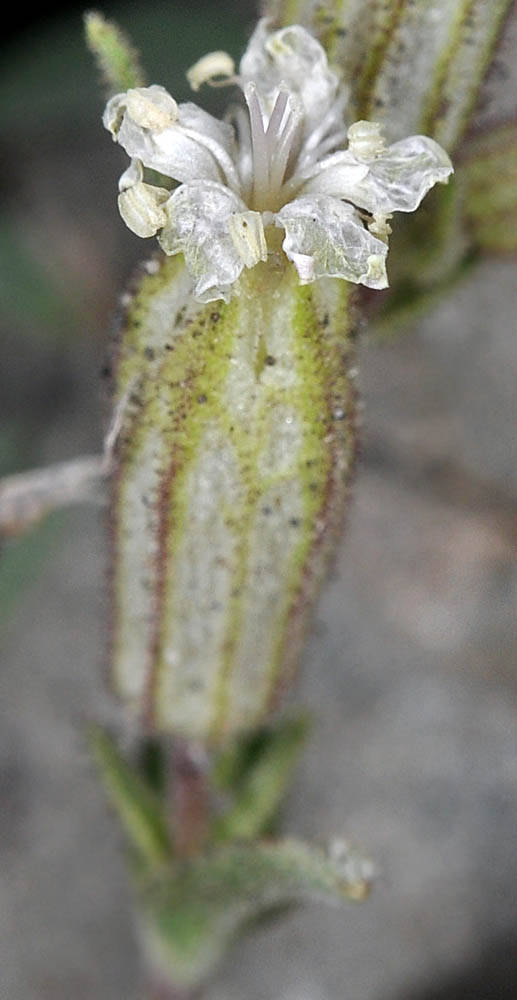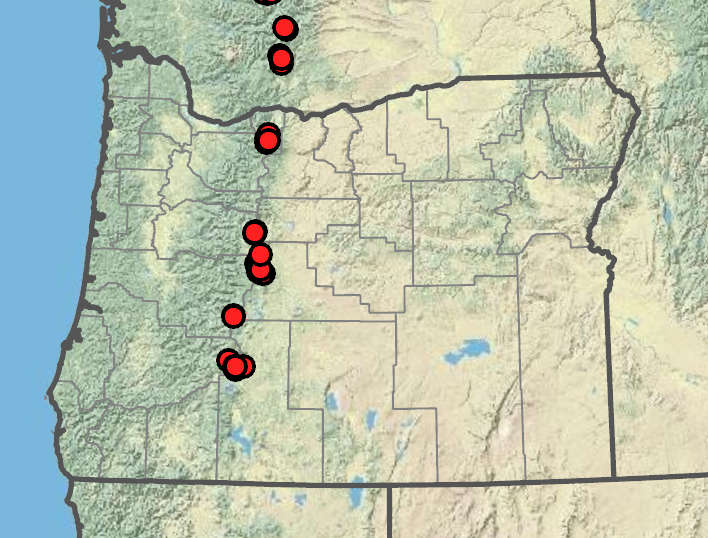Silene suksdorfii
Silene vulgaris
Suksdorf's catchfly
bladder campion
decumbent to erect, 3–15 cm;
branches many, puberulent, glandular-viscid above.
decumbent to erect, 20–80 cm;
branches few, glabrous to glaucous.
basal narrowly oblanceolate, 0.5–4.5 cm × 1.5–3.5 mm, densely tufted; fleshy;
cauline in 1–3 pairs, linear-lanceolate, 0.5–1.5 cm × 1–2 mm, abruptly reduced upward.
lower cauline lanceolate to oblanceolate, 4–8 cm × 5–20 mm; upper cauline lanceolate to ovate, 3–4.5 cm × 5–15 mm, gradually reduced upward.
terminal; open cymes, not 1-sided, or flowers solitary;
pedicels glandular-viscid.
terminal; open cymes, not 1-sided;
pedicels glabrous.
bisexual; erect;
calyces campanulate, not inflated in fruit, 9–12 mm; short-glandular-hairy, prominently 10-veined, not netted above; pale commissures present; commissural veins fork above and fuse with lobe veins, becoming papery;
cell walls of hairs purple;
lobes 1–2 mm;
tips acute to obtuse;
petal claws ciliate at base; appendages 2;
limbs 3–5 mm, white to purplish;
lobes 2;
stamens equaling petal claws;
styles 3(4), equaling petal claws.
bisexual or unisexual (pistillate), nodding to spreading;
calyces campanulate, inflated and becoming papery in fruit, 7–10 mm, glabrous, obscurely 10–15-veined, netted throughout; pale commissures absent;
lobes 2–3 mm; acute to mucronate;
petal claws glabrous; appendages 0 or 2; minute;
limbs 7 mm, white, emarginate or lobes 2, 3–4 mm;
stamens exserted;
styles 3, exserted.
ovoid;
teeth 6(8);
stalks 2–3.5 mm.
subspherical;
teeth 6;
stalks 2–3 mm.
1–2 mm, brown, winged.
1–1.5 mm; black, not winged.
=48.
=24.
Silene suksdorfii
Silene vulgaris
Rocky crevices, ridges, slopes. Flowering Jul–Sep. 1600–2800 m. Casc, ECas. CA, WA. Native.
Roadsides, fields, forest openings. Flowering Jun–Aug. 0–1300 m. Casc, Col, CR, Lava, WV. CA, ID, WA; throughout North America except far north and southeast; Europe. Exotic.
A widespread introduced species, S. vulgaris was first gathered in Oregon on ballast at Linnton (Portland) in 1911.
Rich Rabeler, Ronald Hartman
Rich Rabeler, Ronald Hartman
- Local floras:
CA,
OR,
WA
- Local Web sites:
CalFlora,
CalPhotos,
Flora NW,
PNW Herbaria
WildflowerSearch
iNaturalist (observations)
USDA Plants Database
- LBJ Wildflower Center
- SEINet
- Plants of the World Online
- Encyclopedia of Life
- Wikipedia
- Google Image Search
- Local floras:
BC,
CA,
OR,
WA
- Local Web sites:
CalFlora,
CalPhotos,
Flora NW,
PNW Herbaria
WildflowerSearch
iNaturalist (observations)
USDA Plants Database
- LBJ Wildflower Center
- SEINet
- Plants of the World Online
- Encyclopedia of Life
- Wikipedia
- Google Image Search





